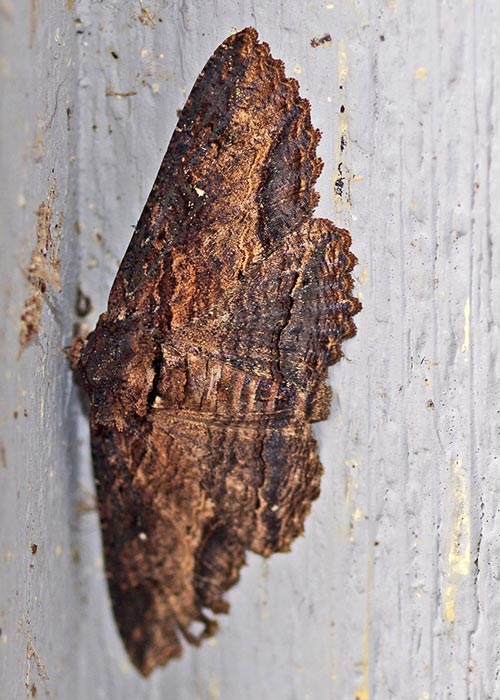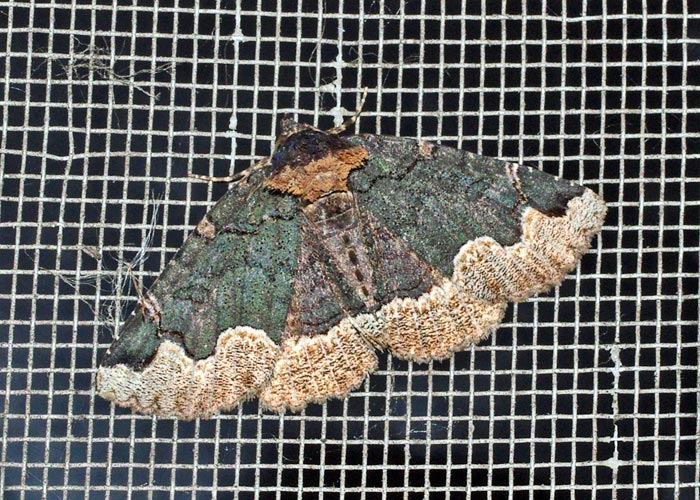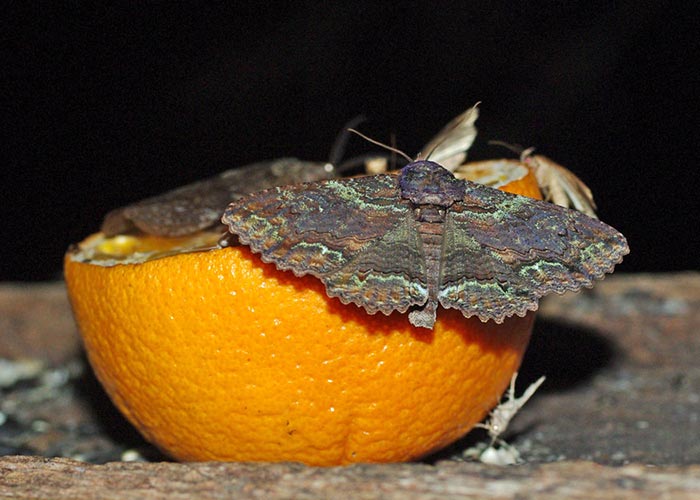Salutations, BugFans,
When the BugLady started researching this episode, she had pictures of three species of Zales, but now she only has two. How did that happen? Read on.
Zale Moths
The Zales are a genus (and a common name) of moths in the Wavy-lined Owlet bunch—family Erebidae and subfamily Ophiusini. They are decent-sized moths (wingspans just under two inches), and oh, those wings! Depending on how worn the moth is, the trailing edge of both the front and the hind wings sport a row of cool little scallops. A few non-Zale species also have scalloped wings, so while it’s not a definitive field mark, it’s a pretty good clue. Despite their often-beautiful markings, Zales are well camouflaged, especially when they land on leaves. Zale moths are equipped with a pair of auditory organs on their thorax that enable then to hear the sounds of hunting bats.

For a long time, the BugLady pronounced the genus to rhyme with “kale” (remember third grade phonics—in a short word ending with “e,” the first vowel sound is long) but she stands corrected—since it’s the moth’s Latin name, Latin vowel sounds apply. And, as BugFans recall, the Latin vowel sounds are ah – ay – ee –long o –and oo, so Zale is pronounced “Zah’-lay.”
Wagner’s Caterpillars of Eastern North America says that “Zale is a large and taxonomically challenging genus with some 25 Eastern species” (there are perhaps another dozen in the West); to get a feel for who lives where, scroll through this Gallery. The caterpillars can be tricky, so Wagner also says that identifications should be based on reared adults, or in some cases, food plant associations.
Zales are related to the underwings, who their caterpillars resemble, except that Zales lack the fringe (subventral rootlet setae) along the sides that disguises the space between an underwing larva’s body and its twig and makes the caterpillar harder to spot. Zale caterpillars are leaf/needle feeders, preferring young, tender leaves in their early instars and tolerating older, tougher leaves in later instars. Many are attached to specific food plants, but some are more generalist feeders. A few species practice “leaf-clipping”—chewing on a leaf and then hiding the evidence by severing the leaf’s petiole so the leaf drops and birds don’t spot the obvious signs of a caterpillar. One of the thread-waisted wasps (of previous BOTW fame), targets both underwing and Zale larvae, making a caterpillar collection for its parasitoid offspring.
Females lay about 200 large, pale green eggs. The eggs hatch within two weeks and spend about a month as larvae; adults typically have a short flight period of less than a month. Zales overwinter in the leaf litter within a pupal case that is said to be covered with a blue-ish “bloom“. Depending on how far north or south they live, Zales may be univoltine (single brood), or bi and even trivoltine.
The caterpillars are consistently described as “muscular,” a word not often used in connection with caterpillars—newly-hatched larvae may trek quite a distance before tucking into a food plant, and when alarmed, they leap vigorously from their perch (a cautionary note for would-be collectors). Both caterpillars and adults are nocturnal.
As they did with the underwings, the moth-christeners had fun with this group—there are Black-eyed, Bold-based, Confused, Dixie, Fawn Virginia Pine, Oblique, the spectacular Okefenokee, and Washed-out Zales.
Horrid Zale
And the Horrid Zale (Zale horrida) (a.k.a. the Scaled Zale), named by German entomologist John Hubner, who must have been a Latin scholar. According to bugguide.net, horrida comes from horridus, which originally meant bristly or rough, standing on end, sticking out, shaggy, or prickly. Try looking here for great images of the horrid bristles, (and the BugLady can’t quite figure this one out, but she’s including a link Grackle Feathers to it anyway).

The Horrid Zale’s wingspread is about 1 ½ inches, which is about the size of its caterpillar. It is found in deciduous woodlands throughout Eastern North America. Its caterpillars feed on viburnums, especially Nannyberry. According to Sogaard, in Moths and Caterpillars of the North Woods, the caterpillars are “striking in their ability to disappear on tree bark.” The Horrid Zale may produce two or three generations a year.
Lunate Zale
And the Lunate Zale (Zale lunata), so-named because of the crescent-shaped markings on its extremely variable, wood-patterned wings. Lunate Zales, considered one of the largest and most common of the Zales, are concentrated in moist woodlands, parks and back yards east of the Rockies, but there are populations on the West Coast, too.

The caterpillars are food generalists, listing the leaves of many members of the rose family (blackberry, raspberry, chokeberry, cherry, plum, and hawthorn) as favorites as well as wisteria, birch, willow, oak, maple, and some wildflowers. There’s probably only one generation here in God’s Country, but Wagner says that there are three or four in New Jersey, and it’s been discovered that the final generation migrates because it’s too cold for the pupae to overwinter. New Jersey seems to be the upper limit for pupal survival.
The BugLady looked at many pictures and really tried to make this Zale-dusted-with-sparkly-green-scales into a Green-Dusted Zale (Zale aeruginosa) (aeruginosa means rust [patina] of copper), and she’s still willing to let someone talk her into it, but for now, she’s labeling it a Lunate Zale. Alas, it’s a matter of “Location, Location, Location.” Green-dusted Zales feed on white oak, live oak, and blueberry, and the nearest of those three is a quarter-mile away from the BugLady’s front porch, where this picture was taken. They have been recorded in Wisconsin, though. The Green-dusted Zale even carries a new vocabulary word with it—their proper habitats include woodlands, forests, barrens, and pocosins. Pocosins? Woodlands with deep, peaty, nutrient-poor, usually-wet soils on the coastal plain of the American Southeast, especially North Carolina.
The BugLady